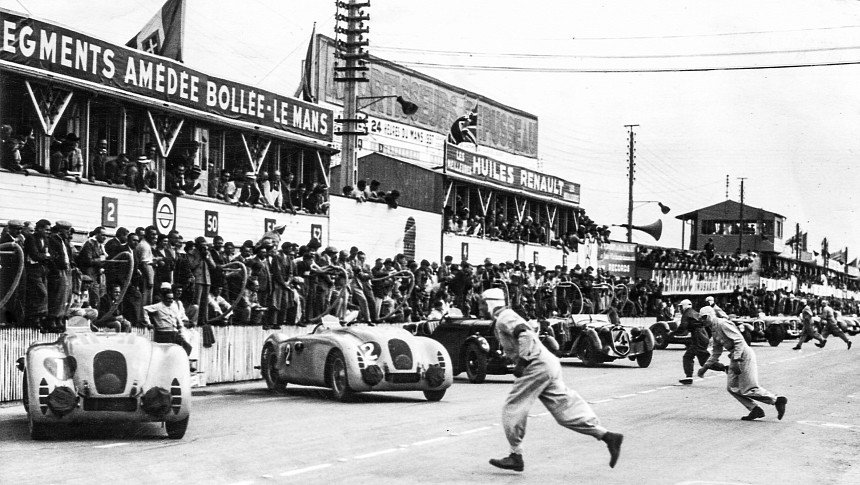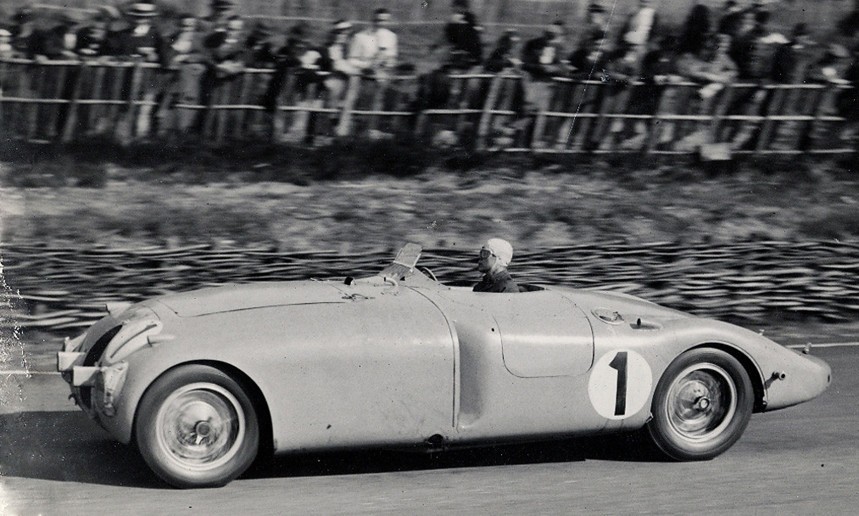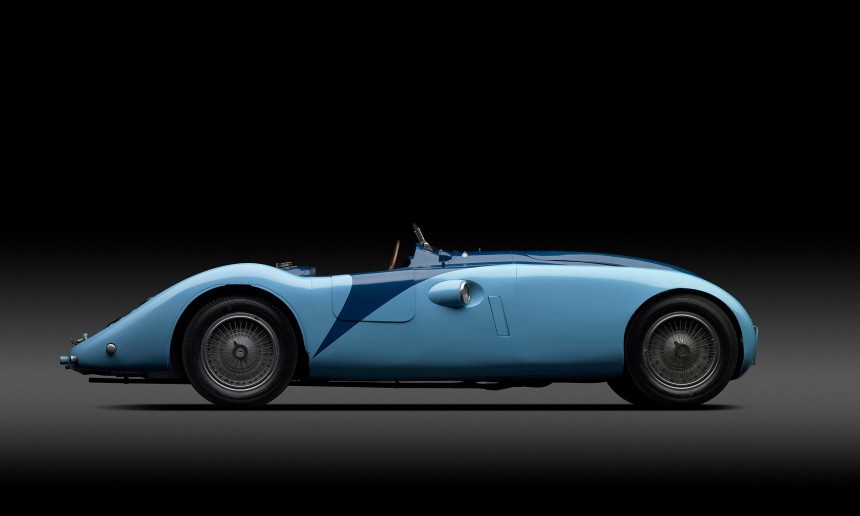Le Mans is celebrating its 100th anniversary, if you haven’t heard, and almost no one has been with the race for as long as Bugatti. Ettore’s brand is inextricably linked to Le Mans, going back to the first-ever running of the race back in 1923.
That year, Bugatti was there, fielding two cars - these were the Brescia 16S cars piloted by Max de Pourtalès and Sosthène de La Rochefoucauld. These were primitive cars - no more than a container for an engine and a driver. I imagine they’re horrifying to drive fast, seeing as the driver is basically perched atop a glorified Radio Flyer wagon, though Bugatti says they were incredibly quick and reliable.
It rained that day, as is so common at the Circuit de la Sarthe. Despite that, both drivers finished inside the top 10. That’s an impressive finish considering the 37 total entrants across four classes. At the time, these were decided by engine displacement - ranging from 1.5 to 3 liters.
Fast forward a few years, and Bugatti is back at Le Mans for the 1930 race. This time, a more memorable name is in use - the Type 40. Its water-cooled inline four-cylinder could push the car to 80 mph (129 kph), an impressive speed for the time - and one that set the trend for Bugatti’s reputation for speed. This time, Bugatti finished inside the top ten yet again, with drivers Odette Siko and Marguerite Mareuse putting the car there. Notably, this was a female duo - a rarity even now at Le Mans.
In the following years leading up to 1937, Bugatti would continue to participate in some capacity in the race. This produced mixed results. P6 in ’32, P9 in ’34, and so on. Until 1937, the podium at the now-renowned race would elude the French brand.
In 1936, new regulations shook things up drastically, prompting Bugatti to start work on the Type 57 Grand Prix. This time, Bugatti was far more prepared on an engineering level. The 57’s 3.2-liter engine made a more respectable 167 horsepower, and the chassis was drilled out to reduce weight without compromising rigidity. On top of that, Bugatti fitted an impressive-by-today’s-standards magnesium alloy body. The car was lightyears ahead of anything on the field at the time, at least mechanically. The result? Jean-Pierre Wimille and Robert Benoist piloted the car to Bugatti’s first-ever Le Mans win. Down the back straight at la Sarthe, the “Tank,” as the 57 was known, hit 137 mph (220 kph). No. Thank. You.
The terrifying prospect of doing 137 mph in a metal box on bike tires aside, that day held many firsts for Bugatti. The duo finished the race a full 100 km (an astonishing 62 miles) ahead of the second-place car. It’s a margin you’re unlikely to ever see in motorsport again. On top of that, the all-French duo covered a record distance within the race time - 3,287 km, or 2,042.47 miles.
As in any form of motorsport, managing that difficult second album, which is to say victory, is always tough. The competition learned a lot from Bugatti in 1938, and the brand had to retire its car in the ’38 running for technical problems. No one’s perfect. Bugatti would return in 1939 with a very important name at the helm. That year, Pierre Veyron (yes, that Veyron) would pilot a much-upgraded version of the Type 57G.
By now, Bugatti was calling the car the Type 57C. Under the hood sat a much upgraded straight-8 engine, now making a much healthier 197 horsepower. The result was a car capable of a staggering 158 mph (254 mph). Bugatti engineers were also able to take weight off the nose of the car’s round, boatlike hood. Unfortunately, the brand doesn’t specify what measures were taken there. Unspecified other changes were made to the rear axle and crank. Notably, Bugatti doesn’t say whether changes were made to the brakes. I’d be a bit nervous about that.
As with so many Le Mans victories, Bugatti’s fate at the race was made by reliability. The Alfa Romeo was tough to beat in 1939, but late in the morning, the car was forced into retirement for a mechanical issue. The Bugatti continued to churn out laps problem free. Ultimately, that solidity, that reliability, is what brought Pierre Veyron a Le Mans victory. Ettore would claim that the mechanics never once opened the hood during the race.
Unfortunately, a major conflict that began in Europe in 1939, well, delayed things for Bugatti. The 24 Hours of Le Mans wouldn’t return for a decade. Along with so many other brands and people, it was occupied by the ravages of the Second World War. France, as it turned out, was not where you wanted to be in the fall of 1939.
For Bugatti, its hiatus would be even longer. The brand faced some tumultuous times in the middle of the 20th century. Ownerships were drawn into question, cars were and were not made, and even a few trains were produced. But those are stories for another time.
In 1994, the French would be back at Le Mans under the Bugatti banner. It had been 55 years since its last running at the Circuit de la Sarthe. Even then, the effort itself was ill-fated, with the EB110 crashing out after a technical issue. From there, unfortunately, things haven’t been so great for Bugatti at Le Mans. It hasn’t participated in a race since then. The new Bolide will be driven on track, but it won’t be racing. Bugatti is not the racing brand it once was, though it never forgets its heritage. Perhaps one day, we’ll get to see a French car on the podium at the most French of all races.
It rained that day, as is so common at the Circuit de la Sarthe. Despite that, both drivers finished inside the top 10. That’s an impressive finish considering the 37 total entrants across four classes. At the time, these were decided by engine displacement - ranging from 1.5 to 3 liters.
Fast forward a few years, and Bugatti is back at Le Mans for the 1930 race. This time, a more memorable name is in use - the Type 40. Its water-cooled inline four-cylinder could push the car to 80 mph (129 kph), an impressive speed for the time - and one that set the trend for Bugatti’s reputation for speed. This time, Bugatti finished inside the top ten yet again, with drivers Odette Siko and Marguerite Mareuse putting the car there. Notably, this was a female duo - a rarity even now at Le Mans.
In 1936, new regulations shook things up drastically, prompting Bugatti to start work on the Type 57 Grand Prix. This time, Bugatti was far more prepared on an engineering level. The 57’s 3.2-liter engine made a more respectable 167 horsepower, and the chassis was drilled out to reduce weight without compromising rigidity. On top of that, Bugatti fitted an impressive-by-today’s-standards magnesium alloy body. The car was lightyears ahead of anything on the field at the time, at least mechanically. The result? Jean-Pierre Wimille and Robert Benoist piloted the car to Bugatti’s first-ever Le Mans win. Down the back straight at la Sarthe, the “Tank,” as the 57 was known, hit 137 mph (220 kph). No. Thank. You.
The terrifying prospect of doing 137 mph in a metal box on bike tires aside, that day held many firsts for Bugatti. The duo finished the race a full 100 km (an astonishing 62 miles) ahead of the second-place car. It’s a margin you’re unlikely to ever see in motorsport again. On top of that, the all-French duo covered a record distance within the race time - 3,287 km, or 2,042.47 miles.
As in any form of motorsport, managing that difficult second album, which is to say victory, is always tough. The competition learned a lot from Bugatti in 1938, and the brand had to retire its car in the ’38 running for technical problems. No one’s perfect. Bugatti would return in 1939 with a very important name at the helm. That year, Pierre Veyron (yes, that Veyron) would pilot a much-upgraded version of the Type 57G.
As with so many Le Mans victories, Bugatti’s fate at the race was made by reliability. The Alfa Romeo was tough to beat in 1939, but late in the morning, the car was forced into retirement for a mechanical issue. The Bugatti continued to churn out laps problem free. Ultimately, that solidity, that reliability, is what brought Pierre Veyron a Le Mans victory. Ettore would claim that the mechanics never once opened the hood during the race.
Unfortunately, a major conflict that began in Europe in 1939, well, delayed things for Bugatti. The 24 Hours of Le Mans wouldn’t return for a decade. Along with so many other brands and people, it was occupied by the ravages of the Second World War. France, as it turned out, was not where you wanted to be in the fall of 1939.
For Bugatti, its hiatus would be even longer. The brand faced some tumultuous times in the middle of the 20th century. Ownerships were drawn into question, cars were and were not made, and even a few trains were produced. But those are stories for another time.












